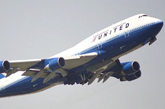The world's biggest airline has got clearance for take-off as shareholders of United Airlines and Continental Airlines backed a multi-billion dollar merger that will create a carrier dwarfing rivals on both sides of the Atlantic.
The combined airline, which will adopt United's name, is forecast to have US$30 billion of annual revenue, carrying 144 million passengers a year to 59 countries, reported The Guardian.
It will be larger than Europe's top carrier, Air France-KLM, and will overtake its US rival, the newly merged combination of Delta Air Lines and Northwest.
Investors met to vote on the tie-up at twin meetings at Continental's headquarters in Houston and at United's base in Chicago. At Continental's gathering, 98 percent of votes were cast in support of the share-swap deal, despite concerns among unions about job losses, plus opposition in some circles to the abandonment of United's signature "tulip" logo.
"We are grateful for our stockholders' strong vote of confidence in this merger," said Continental's boss, Jeff Smisek, who will be chief executive of the combined company. "Our stockholders recognised the value of bringing together Continental and United to create a platform for increased profitability and sustained long-term value."
Hampered by over-capacity, a tough economic outlook and fierce price competition, airlines in the US have struggled to make sustainable profits. Several top carriers, including United, filed for bankruptcy protection early in the past decade as they suffered slumps in traffic following the attacks of September 11, 2001.
"It's a mature market and there are too many costs in the system given the level of revenue," said Basili Alukos, airlines analyst at research firm Morningstar in Chicago. "The combined network of United and Continental is very complementary and should work well as a whole."
Industry experts say the carriers have relatively little geographic overlap. United is particularly strong in the west of the US and on flights across the Pacific to Asia, while Continental has a big presence in southern and eastern states, with a broad network of flights to Latin America. Both fly transatlantic routes to London, and Continental serves several other British cities, including Bristol, Belfast, Edinburgh and Birmingham.
The deal means an end to a long history of independence for both carriers. United was founded as a mail carrier in 1926, while Continental, originally called Varney Speed Lines, followed in 1934 with a 530-mile inaugural flight between Pueblo, Colorado and El Paso, Texas.
In a compromise thrashed out between the airlines, the combined operation will be called United and based in Chicago but will adopt Continental Airlines' logo of a yellow globe on a blue background. But the issue of livery has aroused controversy among some of United's customers: one Boston-based frequent flier, Timothy Jasionowski, has started a campaign to save United's red and blue tulip logo.
"It's a brand that harks back to the golden age of flight, when air travel was about more than just getting from point A to point B," said Jasionowksi, who described United's logo as "a Powerpoint clip-out". He added: "They're casting aside something with not only sentimental but symbolic value".
Unions, too, are sceptical. The International Association of Machinists and Aerospace Workers said the deal would mean less choice, higher fares and poorer service for travellers. And consumers' organisations argue that combining the airlines would mean disruption for passengers.
It seems to be understood that the merger will lead to lay-offs. Bill McGee, aviation consultant at the Consumers Union, recently told a Congressional committee: "These sterile corporate terms - downsizing, rightsizing, outsourcing, offshoring, furloughing - really mean that two workforces already shell-shocked from two decades of layoffs will experience more trauma."
The deal was cleared by the United States department of justice last month and is likely to be legally complete by the beginning of October. Staff have been told to prepare for a "customer day one" in the spring, when combined services begin in earnest.
Cargonews Asia













